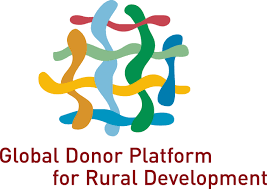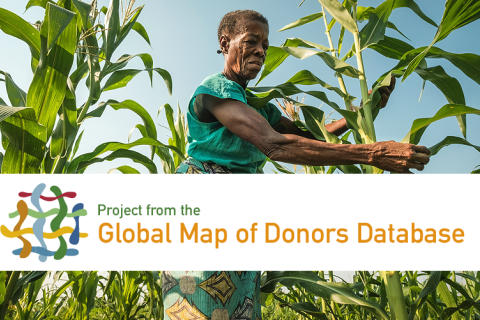The Global Donor Platform for Rural Development is a network of 38 bilateral and multilateral donors, international financing institutions, intergovernmental organisations and development agencies.
Members share a common vision that agriculture and rural development is central to poverty reduction, and a conviction that sustainable and efficient development requires a coordinated global approach.
Following years of relative decline in public investment in the sector, the Platform was created in 2003 to increase and improve the quality of development assistance in agriculture, rural development and food security.
// Agriculture is the key to poverty reduction
Agriculture, rural development, and food security provide the best opportunity for donors and partner country governments to leverage their efforts in the fight against poverty.
However, the potential of agriculture, rural development and food security to reduce poverty is poorly understood and underestimated.
Cutting-edge knowledge of these issues is often scattered among organisations, leading to competition, duplication of efforts, and delays in the uptake of best practices.
// Addressing aid effectiveness
Therefore the Platform promotes the principles of the Paris Declaration on Aid Effectiveness, the Accra Agenda for Action for sustainable outcomes on the ground, and the Busan Global Partnership for Effective Development Cooperation.
Increasing aid to agriculture and rural development is not enough. Donors must work together to maximise development impact.
// Adding value
The Platform adds value to its members’ efforts by facilitating the exchange of their development know-how, which consolidates into a robust knowledge base for joint advocacy work.
Working with the Platform, members are searching for new ways to improve the impact of aid in agriculture and rural development.
- An increased share of official development assistance going towards rural development
- Measurable progress in the implementation of aid effectiveness principles
- Greater use of programme-based and sector-wide approaches
- More sustainable support to ARD by member agencies
// Vision
The Platform endorses and works towards the common objectives of its member institutions to support the reduction of poverty in developing countries and enhance sustainable economic growth in rural areas.
Its vision is to be a collective, recognised and influential voice, adding value to and reinforcing the goals of aid effectiveness in the agricultural and rural development strategies and actions of member organisations in support of partner countries.
// Evaluation
Between August and October 2014, the Global Donor Platform for Rural Development underwent an Evaluation. The evaluators interviewed across board focal points (FPs) of member organisations, partner institutions, staff of the secretariat and key agricultural and rural development experts from different organisations involved in the Platform initiatives. KIT reviewed Platform documentation of the past 10 years, online resources and services to complete the assessment.
According to the report, the change in overall global development objectives of the Post-2015 agenda and its sustainable development goals (SDG) will only reiterate the relevance of the Platform’s work in coordinating donor activities. Agriculture and rural development are incorporated in many of the SDGs. The targeted development of appropriate policies and innovative strategies will depend on increased, cross-sectoral cooperation which the Platform stands for. The achievement of the Platform’s objectives of advocacy, knowledge sharing and network facilitation functions remains to be a crucial contribution to agriculture and rural development.
Members:
Resources
Displaying 356 - 360 of 808Biodiversity, climate change and sustainable development
General
Indigenous communities and producer organisations implement models for sustainable use of biodiversity with consideration of climate change.
Land Market Development Activity
General
The Feed the Future Tajikistan Land Market Development Activity (LMDA) promotes market based principles for land tenure and aims to establish a functional agricultural land market that allows for the transferability of land use rights (such as buying, selling, or leasing land use rights), to ensure a simple and transparent land registration process, while promoting gender equality in rights and processes. The project focuses on land policy and legal development, private sector development, simplification of land registration procedures, and expansion of knowledge surrounding land use rights to rural governmental administrations and citizens, especially female landholders. USAID supports the Government of Tajikistan’s agrarian reform effort to increase agricultural productivity through the U.S. government’s Feed the Future initiative working to: strengthen land rights; expand the availability of quality agricultural inputs; crop diversification; and market development. The Feed the Future Tajikistan Land Market Development Activity supports the Feed the Future initiative, and continues USAID’s effort to support land reform and farm restructuring in Tajikistan, which began in 2004.
Support the implementation of the Voluntary Guidelines on Responsible Governance of Tenure
General
A national workshop on the Voluntary Guidelines was held in Libreville during 14-16 January to help to strengthen the national dialogue on the most pressing tenure challenges and opportunities in Gabon and the use of the Voluntary Guidelines in light of ongoing reforms. The participants agreed to create a multi-sectoral committee to continue striving for improved governance of tenure and to formulate a cross-sectoral strategy for implementing the Voluntary Guidelines in Gabon at all levels. The workshop was co-organized by the Ministry of Agriculture, Livestock, Fisheries and Food Security, the General Secretariat of the Government of Gabon and FAO. It brought together 75 representatives from the national tenure administration, farmers' organizations, civil society, international organizations, the private sector, NGOs and academia.
Support Project for the Strategic Plan for the Transformation of Agriculture (PAPSTA)
General
The goal of the project was to contribute to the poverty reduction process by providing implementation support to the Strategic Plan for the Transformation of Agriculture (PSTA) which aims to effect a gradual shift from prevailing subsistence agriculture to market-based farming. The project helped the government address the main development constraints and challenges identified within the PSTA. It aimed to strengthen the capacity of key stakeholders to implement agricultural development plans in potential growth areas within the PSTA framework. The project aimed to benefit 10,000 households, giving priority to households headed by women, as well as young people, landless people, orphans and families affected by HIV/AIDS and civil war, in the districts of Budaha, Bukonya, Karaba, Ngenda, Nyamure and Rusumo. It intended to undertake actions to overcome the main constraints related to soil fertility and watershed protection, livestock improvement, increasing rice production and intensifying research and extension. With regard to land and natural resource governance, the project intended to provide support for a sustainable and productive water and land management system, it used watershed management plans and linked them to value chain plans undertaking participatory planning exercises addressing land tenure issues.
Rural Income Promotion Programme (PPRR)
General
The goal of the programme was to reduce rural poverty by increasing incomes through better market access and improving the grassroots of 30,000 households to support their development in the province of Toamasina. On land and natural resource governance, the programme supported the improvement of local governance and decentralization through activities related to the local land planning and supported the establishment of offices dealing with land issues and the issuance of 1736 small-land producers certificates. Collective titles were allotted to villages to strengthen land tenure security of target groups in the context of increased land values following the improvements funded by the project.


